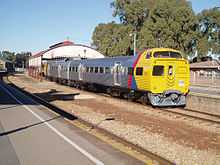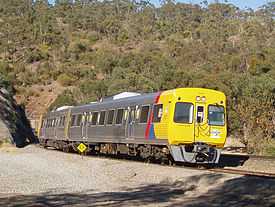TransAdelaide
 | |
| Former type | Government Owned Corporation |
|---|---|
| Industry | Public transport |
| Predecessor(s) | State Transport Authority (STA) |
| Founded | July 1994 |
| Defunct | late 2010 |
| Headquarters | Adelaide, Australia |
| Area served | Adelaide, Australia |
| Products | Rail Transport services |
| Parent | South Australian Government |
| Divisions | Office of Public Transport |
| Website | |
| TransAdelaide | |
|---|---|
 Adelaide railway network | |
| Locale | Adelaide |
| Dates of operation | 1994–2010 |
| Track gauge | 5 ft 3 in (1,600 mm) |
| Electrification | 2010-2013 |
| Length | 120 km |
| Headquarters | Adelaide |
TransAdelaide was a publicly owned corporation which provided suburban train and tram services in Adelaide, South Australia, under contract to the Government of South Australia.
Between 4 July 1994, and 22 April 2000, TransAdelaide also operated local bus services in Adelaide. All metropolitan bus routes have since been transferred to private companies such as Torrens Transit, but TransAdelaide retained the contract to maintain and operate the rail system until at least April 2010.
TransAdelaide was part of the Adelaide Metro public transport system. Adelaide Metro is a trading brand of the S.A. Government’s Office of Public Transport, which provides funding, coordination and a central publicity and marketing service for public transport in the city. Adelaide Metro also administers the Metroticket system, which allows unlimited transfers between all buses, trains and trams in the Adelaide metropolitan area within a ticket’s period of validity.
TransAdelaide was abolished in late 2010, and its staff and functions were transferred to the newly created Office of the Rail Commissioner.[1]
Operations
TransAdelaide operated four main rail lines and two branch lines, with a total length of 120 km. In 2006 there are 240 round-trip train journeys on Monday to Fridays (plus an extra two on Fridays), 95 on Saturdays and 88 on Sundays. In the 12 months to 30 June 2009, the train system was used by a total of 11.74 million passengers, while 2.62 million used the Glenelg tram. The total train patronage in the suburban TransAdelaide network is lower than the country train network in Victoria, which recorded 12.05 million passenger trips in the same period.
Adelaide is the last suburban rail network in Australia to be electrified, with some funding provided in the 2008-09 State Budget to commence work. A$245 million has been allocated to the Outer Harbor line and A$209.7 million for the Noarlunga line.[2] The Proposed 10-year, A$2 billion program intends to deliver 50 new electric trains, 58 3000 class railcars converted for electric use, 15 hybrid tram/trains. The 2000 class cars will be removed from suburban service.[3]
After retiring the last of the aging Redhen railcars in 1996, TransAdelaide operated 99 broad-gauge diesel railcars, split into two classes and four types - the diesel-hydraulic powered 2000 and 2100 classes and the diesel-electric 3000 and 3100 classes. All were maintained by Bombardier at a central depot adjacent to Adelaide station.
The Adelaide–Glenelg tram line was also operated and maintained by TransAdelaide. The tram line had undergone a major A$71 million overhaul in 2005–2006 with new Bombardier Flexity light-rail vehicles replacing the aging H-type trams which had been in service since 1929. During 2007, the tram line was extended from its previous city terminus at Victoria Square along King William Street to the railway station. In 2010, the tram was further extended to the inner north west suburb of Hindmarsh, terminating outside the Entertainment Centre.
In 2006, TransAdelaide installed Rail Real Time electronic information boards at these stations:
- Belair line
- Goodwood
- Mitcham
- Coromandel
- Blackwood
Fleet
3000 and 3100 class
The 3000-class are a diesel railcar with driving cabs at both ends that can operate singly, or in multiple with other 3000 and 3100-class units to build up trains of 2, 3 or 4 cars. 30 cars were delivered, all of which are in service. TransAdelaide regularly used single cars on lightly patronised routes such as the Tonsley and Grange lines, and on the main lines at weekends or in the evening.
The 3100-class railcars are generally similar to the 3000-class, but have only one driving cab per car. They always operate in pairs as two-car sets, or in multiple with other 3000 or 3100-class units to form longer trains. All 3100-class railcars are currently in service.
Both the 3000 and 3100-class units were built in two batches, by Clyde Engineering and Comeng. When delivered all 3000 and 3100-class railcars were painted in an orange and blue State Transport Authority livery. However by 2007 all 3000 and 3100 class railcars have been repainted into the South Australian State colours of yellow, blue and red which are standard across the Adelaide Metro bus and light rail fleets.
By 2018, 58 of the 70 cars will be converted to electric power with 12 remaining diesel powered for Belair line services. These trains are currently being refurbished with an improved interior, fully automatic doors and enhanced security. The entire 3000/3100 fleet will be refurbished by 2012-2013.
2000 and 2100 class

TransAdelaide’s 2000 & 2100-class units are a unique and somewhat unusual series of suburban diesel railcars. They are large, comfortable, air-conditioned cars, which are popular with local rail enthusiasts and regular commuters and have been given the nickname 'Jumbos'. Jumbos come in two distinct varieties – the 2000-class power cars and 2100-class trailers. Each type has a single elevated driver’s cab at one end only, which means they must operate as a minimum 2-car set. Longer trains are built up by adding extra power cars and trailers with 6 cars being the maximum length.
Jumbos were conceived and designed in the late 1970s to provide fast commuter services to Adelaide's expanding suburbs. They perform much the same function today, being used mainly on weekday daytime services and working the busiest express trains in the morning and evening peaks. Off-peak, evening and weekend rail services in Adelaide are usually operated by the more economical 3000 & 3100-class units.
Bombardier Flexity Trams
In 2006, TransAdelaide began to replace the H-class cars with a fleet of eleven new low floor articulated trams – the Flexity Classics, built by Bombardier in Germany. The first of the new Flexities was delivered to the Glengowrie depot in November 2005, and entered public service on 9 January 2006. Delivery continued in small batches through 2006, with new trams operating the Glenelg line side-by-side with the H-class in the interim. The Flexitys are painted in a standard Adelaide Metro colour scheme of white, with yellow, blue and red ends, very similar to Adelaide’s metropolitan bus fleet.
Alstom Citadis Trams
In May 2009 it was leaked that the State Government had purchased six Citadis 302 five car trams made in France by Alstom. These trams were originally for the Metro Ligero system in Madrid, Spain, but are now considered "superfluous." Costing A$3 million each, they are expected to be running by December 2009.[4]
Fleet Table
| Class | Image | Type | Top speed | Number | Routes operated | Built | |||
|---|---|---|---|---|---|---|---|---|---|
| mph | km/h | Limit mph/h |
Limit km/h | ||||||
| 3000 Class |  |
Diesel-Electric Multiple Unit | 87 | 140 | 56 | 90 | 30 | All Routes Except Glenelg Tramline |
1987- |
| 3100 Class |  |
Diesel-Electric Multiple Unit | 87 | 140 | 56 | 90 | 40 | All Routes Except Glenelg Tramline |
1988-96 |
| 2000 Class Jumbos |  |
Diesel Multiple Unit | 87 | 140 | 56 | 90 | 11 | Gawler Central, Grange, Noarlunga Centre, Outer Harbor, Tonsley | 1980 |
| 2100 Class Jumbos |  |
Control Car | 87 | 140 | 56 | 90 | 18 | Gawler Central, Grange, Noarlunga Centre, Outer Harbor, Tonsley | 1980 |
| Flexity Classic |  |
Tram | -- | -- | 50 | 80 | 15 | Glenelg | 2006 |
| Alstom Citadis |  |
Tram | -- | -- | -- | -- | 6 | Glenelg | 2009 |
Future fleet
Funding has been provided in the 2008-09 State Budget for electrification, with A$245 million to start work on the Outer Harbor rail line and A$209.7 million for the Noarlunga line.[5] The 10-year, A$2 billion program will deliver 50 new electric trains to complement the 58 existing trains converted for electric use and 15 hybrid tram/trains.[6] The invitation to tender was issued in 2009.
Past fleet
TransAdelaide used to operate 74 300 Class and 37 400 Class diesel railcars commonly known throughout Adelaide as RedHens. These were inherited from the South Australian Railways and the State Transport Authority (STA) respectively. The final units were retired in October 1996.
The H class Adelaide tram were the mainstay of the Glenelg tram line for 75 years since the line was converted from railway to tramway operation and electrified in 1929. Formerly operated by TransAdelaide, all of the class have been replaced by new Bombardier Flexity Classic low-floor trams. It is uncertain if the weekend tourist operation of these trams will continue.

See also
Adelaide
- Transport in Adelaide
- Adelaide Metro
- Buses in Adelaide
- O-Bahn Busway
- Railways in Adelaide
- Trams in Adelaide
Other Superseded Transport Authorities
- State Transport Authority, South Australia
Australia
References
- ↑ End of the line for TransAdelaide September 6, 2010
- ↑ Starick, Paul (5 June 2008). "AdelaideNow... SA Budget - Electric trains, trams to the Port". www.news.com.au. Retrieved 5 June 2008.
- ↑ "AdelaideNow... State Budget 08 - Foley unveils A$10bn infrastructure masterplan". www.news.com.au. 5 June 2008. Retrieved 5 June 2008.
- ↑ Castello, Renato (24 May 2009). "European trams to bolster our City-Glenelg fleet". The Advertiser - News Corporation. Retrieved 4 June 2009.
- ↑ Starick, Paul (5 June 2008). "AdelaideNow... SA Budget - Electric trains, trams to the Port". www.news.com.au. Retrieved 5 June 2008.
- ↑ "AdelaideNow... State Budget 08 - Foley unveils A$10bn infrastructure masterplan". www.news.com.au. 5 June 2008. Retrieved 5 June 2008.
External links
- TransAdelaide (official site)
- Adelaide Metro
- South Australian Office of Public Transport
| ||||||||||||||||
| |||||||||||||||||||
